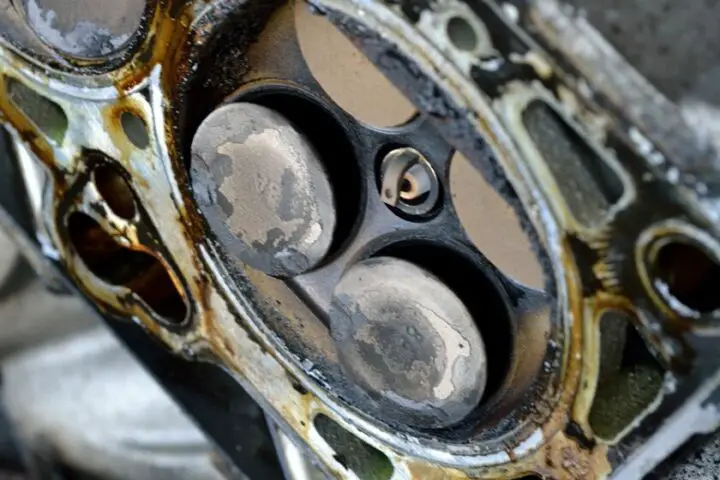Last Updated on January 29, 2024 by Pittalks
Proper maintenance of engine valves is critical for ensuring the smooth operation and longevity of your vehicle’s engine. Carbon buildup on engine valves can lead to restricted airflow and increased operating temperatures, which in turn can cause damage to the engine. Cleaning the valves regularly helps in maintaining optimal engine performance and preventing potential mechanical issues.
When undertaking such maintenance tasks, it’s imperative to prioritize personal safety. Work should always be conducted while wearing appropriate gloves and eye protection to safeguard against burns and harmful substances. It is equally important to perform the cleaning in a well-ventilated area, using the correct protective gear to minimize exposure to chemicals and fumes. This approach ensures the user’s safety while effectively enhancing the engine’s functionality without the need for disassembling the cylinder head.
How to clean carbon build up on valves ?
Step 1: Preparation: glasses and gloves to protect yourself
Before cleaning valves, one should wear safety glasses and gloves to protect against chemicals and prevent burns. Protective gear shields against any splashing of cleaning fluids and safeguards the hands while working with a running engine.
Step 2: Set your engine to operating temperature
An engine must reach its operating temperature before cleaning the valves. The temperature gauge on the dashboard will indicate when the engine is warm enough, typically between the cold and hot indicators.
Step 3: Get the cover of the air filter out:
Accessing the valve cleaning area requires removing the air filter cover. Loosen the hose clamps and remove the wing nuts to detach it. Some models might not have wing nuts. Once removed, this is a good opportunity to clean or replace the air filter.
NOTE: Keep all the loose parts safely after opening as you will need to resemble an air filter cover afterward.
Step 4: MAF Sensor
Identify the MAF sensor, usually located between the airbox and the throttle body, before proceeding. It is crucial to spray the cleaner downstream of the MAF sensor to avoid damaging it or triggering engine warning lights.
Step 5: Rev the engine to 2,000RPM
To prepare for cleaning, rev the engine to about 2,000 RPM. This ensures that the engine is running at an elevated speed to facilitate the cleaning process. Assistance from another person might be helpful at this step to maintain the required RPM.
Step 6: Spray valve cleaner
Carefully spray the valve cleaner after the MAF sensor. Do not spray the cleaner in front of the sensor to avoid the check engine light activating. A recommended product for this purpose is the CRC GDI IVD Valve & Cleaner.
CRC GDI IVD Valve & Cleaner

This cheap product will do the job just fine.
Step 7: Spraying the intake cleaner
While the engine maintains 2,000 RPM, spray the intake cleaner for 30 seconds or until the can is empty. Should the engine show signs of stalling, increase gas to no more than 3,500 RPM, ensuring that the cleaner is distributed properly and does not pool, to avoid carbon accumulating in the valves.
Step 8: Rev the engine up to 3500 RPM
Following the intake cleaner application, allow the engine to idle for 1-2 minutes at a maximum of 3,500 RPM, then switch off the engine. This step ensures that any cleaner and loosened debris is expelled through the exhaust.
Step 9: Reassemble
Finally, reassemble any disassembled parts, including the air filter cover. Ensure that everything is secured back in place and that there are no loose components after completing the valve cleaning process.
How to clean intake valves ?
Cleaning intake valves is crucial for maintaining the air-fuel mixture ratio, enhancing fuel atomization, and ensuring optimal combustion efficiency. Here’s a concise procedure:
- Begin with a Warm Engine: Ensure the engine is running and maintain a consistent 2500 RPM. This process requires a warm engine for the best results.
- Water Induction Method: Carefully introduce water into the air intake. As the engine processes the water, it converts it to steam, which helps to clean the valves.
- Oven Cleaner Technique: Apply oven cleaner inside the valve, then vacuum out the residue to remove carbon build-up.
- Chemical Assistance: Adding Toluene or Xylene to your gasoline at a 20% ratio can improve combustion in the chambers, aiding in carbon deposit removal.
Regular maintenance of the intake system supports the long-term health of both the combustion chamber and the exhaust valve, preventing performance degradation.
Best way to clean valves
In my experience, using a bench grinder with a wire wheel is the best way to clean valves. This way is easy and no any damage happened. In case you have no grinder, it still works with a metal wire wheel. It may take longer but at least it can get your job done.
Otherwise:
- Use of Valve Cleaner Spray: Apply quality intake valve cleaner spray to dissolve carbon deposits.
- Intake Valve Cleaner: Opt for cost-effective, specialized cleaning solutions that are designed for intake valves.
- Ultrasonic Cleaning: Consider ultrasonic cleaners for thorough, damage-free cleaning.
- Additives: Quality additives to the fuel system can also help clean valves during operation.
Important notes for driver
- Regular Maintenance: To ensure optimal engine performance and longevity, conduct regular maintenance checks of fuel systems and perform oil changes as needed.
- Performance & Efficiency: Cleaning valves as part of ongoing engine maintenance can help maintain vehicle efficiency and performance levels.
- Fuel Efficiency: Use high-quality fuel to prevent premature valve dirt accumulation and maintain fuel efficiency.
- Precautions: Prior to disconnecting any fuel lines during cleaning, release all residual fuel pressure to minimize risk.
- Engine Performance: Ensure all combustion residues are cleared without introducing hazardous materials that could impair engine performance and emissions control.
- Longevity: Avoid using hard blast media for cleaning as it may damage valve rings and cylinders, affecting the engine’s longevity.
- Safety:
- Fuel Tank: Never smoke near the fuel tank or when using flammable aerosol cleaners.
- Ventilation: Work in a well-ventilated area to prevent inhaling toxic fumes from solvents.
Note: Avoid using a vacuum in the presence of liquids and ensure valves are closed when using blast media for cleaning.
Final words
To summarize the valve-cleaning procedure without head removal, one should meticulously execute each step. Start by uncovering the filter housing to access the MAF sensor. When applying the cleaner, maintain engine revs at 2500 RPM to ensure thorough distribution. Post-cleaning, allow the engine to idle, keeping below 3500 RPM. Remember, choosing the correct cleaning agent is paramount to safeguard your engine against potential damage. Reassemble all components once completed.
FAQs
There are some common questions related to how to clean valves without removing the head.
What causes valves to go bad?
Valves can deteriorate due to various factors, such as thermal stress, mechanical wear, and depositional interference. Heat fatigue, pitting, or actual material breakage may also contribute to valve failure. Over time, continual exposure to high temperatures and pressures can lead to a distortion of the valve seat and erosion of the valve material.
What are the symptoms of dirty valves?
Dirty valves can manifest several symptoms:
- Increased oil consumption
- Emission of excessive smoke
- A noticeable decline in engine power
- Stalling and rough idling
- Difficulty with engine braking
- Challenges during cold starts and off-throttle braking
Dirty valves can also lead to an increase in carbon buildup within the engine.
What causes carbon buildup on the valve?
Carbon accumulates on valves when oil flows or seeps through valve seats or from the crankcase via blow-by gases. Usage of mixed or low-quality fuels can exacerbate carbon deposits. Regular oil changes and the use of quality fuel can help mitigate this issue. Proper lubrication is crucial, but excess oil can burn on hot valves, resulting in significant carbon residue.
What does a bad valve sound like?
A malfunctioning valve can produce a distinct noise. If a valve spring breaks or if there’s significant wear on the camshaft lobe, a tapping or clicking noise may be heard from the engine. This is often compared to the sound a sewing machine makes.
What is the best valve cleaner?
When selecting a valve cleaner, it is important to choose a product that effectively removes carbon deposits without damaging the engine components. Some popular valve cleaner options include:
Other cleaners that are also respected for their efficacy include:
- CRC 05103 QD
- WD-40 throttle body cleaner
- Berryman B-12 Chemtool intake valve cleaner
- ATP AT-100 Intake blast valve cleaner
The choice of cleaner should be based on the specific needs of the engine and adherence to the manufacturer’s recommendations.

